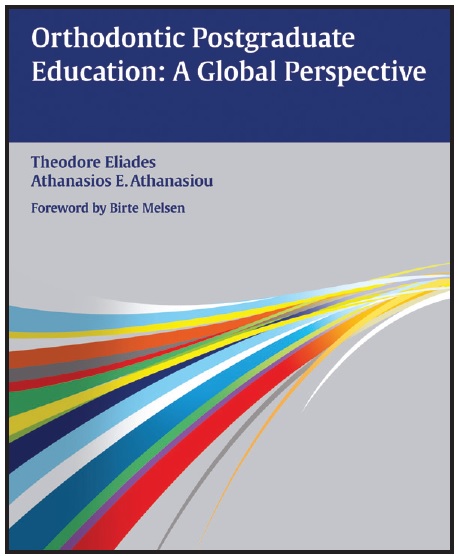BOOK REVIEW
Orthodontic Postgraduate Education: A Global Perspective
THEODORE ELIADES, DDS, MS, DMS, PhD, FRSC, FIMMM, FRSM, FIP
ATHANASIOS E. ATHANASIOU, DDS, MSD, DD
180 pages, 32 illustrations. $89.99. 2015.
Thieme Publishers, 333 Seventh Ave., New York, NY 10010.
(800) 782-3488; www.thieme.com.
This book provides valuable information about the academic, research, and clinical elements of postgraduate orthodontic programs worldwide. Of the 20 chapters, the first two outline the history of postgraduate education and various attempts to establish a standardized curriculum. The third focuses on the undergraduate orthodontic curriculum and addresses the shortage of specialists in some regions. Of particular interest are chapters 4 through 12, which break down postgraduate education throughout the world. The similarities and differences discerned by the authors among Europe, the United States, and Asia (to name a few) are incredibly informative, pointing toward a more universal curriculum.
Chapters 13 and 14 discuss various components of postgraduate education, from evidence-based teaching to research and continuing education. Chapter 15 covers international guidelines, while chapter 16 describes new technologies in light of the increasing popularity of interactive modules and e-learning. This shift from textbooks to digital resources is changing the way younger generations are educated, providing us educators with more opportunities for online collaboration in a truly global teaching experience.
Similar articles from the archive:

Chapter 17 focuses on continuing education and the ability to question claims and think critically, considering the explosion of courses offered by orthodontic companies. As the authors point out, practitioners need to be wary of the latest technologies being advertised before they undergo thorough product research and evaluation. With more and more orthodontic products being marketed to general dentists and the public at large, it is the educator¢s role to help cultivate the skills required to stay up to date on product research, to assess and critique published articles, and to practice evidence-based rather than market-driven orthodontics. Chapters 18 and 19 discuss the roles of scientific journals and research, respectively, in orthodontic specialty education; the final chapter describes the evolution of assessment criteria and methods needed to meet future challenges.
Overall, this book will be an important resource for dentists who are interested in postgraduate orthodontic programs, for orthodontic educators around the world, and for clinicians who simply want to stay abreast of trends in specialty education. It can also serve as a guide for planning and amending orthodontic curricula. Drs. Theodore Eliades and Athanasios have done an excellent job of covering the global educational environment in orthodontics.
JAE HYUN PARK, DMD, MSD, MS, PhD

